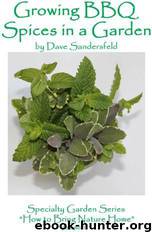Growing BBQ Spices in a Garden by Dave Sandersfeld

Author:Dave Sandersfeld
Language: eng
Format: mobi
Publisher: CreateSpace
Published: 2012-10-06T06:00:00+00:00
SOME SELECTED HERBS
ANISE
(Pimpinella Anisum)
This plant is best known for the source of seeds to create the liqueurs “Anisette”. Fresh chopped leaves add a soft licorice-like taste to marinades or BBQ sauces for lamb or pork.
COLD TENDER PERENNIAL
ZONES: ALL
HABITAT: Native to Mediterranean, Asia minor and Egypt. The seed was an ancient trade item into Europe.
HEIGHT: 1 foot tall and wide
SEED: Direct seed in early spring. Average germination is 17-30 days space about 12 inches apart. Fast growing plants prefer full sun, average, well-drained soil and regular weekly water during growth. Dry period for seed ripening.
INTERNET SOURCE: www.horizonherbs.com
BASIL
(Ocimum Basilicum)
It was used for herbal flavoring dishes long before the time of Christ. Fresh Basil tastes mildly like licorice and the dried leaf has a more lemon anise flavor. However, one can now buy a clove or cinnamon or other varieties of Basil for your BBQ Garden. Note: pick leaves just before flower buds open for the strongest flavor of each! Tomatoes and basil go hand in hand. Throw stems on BBQ coals to flavor meat also!
TENDER ANNUAL THAT WILL NEED TO BE RE-SEEDED
ZONES: All
HABITAT: Originally grew in tropical Asia and Africa.
NOTE: All recipes that call for dried herbs –use three times as much fresh herb for dried!
HEIGHT: 2.5 tall and 2 feet wide.
SEED: Plant seed after soil is above 60 degrees F. in enriched, moist warm soil in full sun. Germination occurs within 7 to 10 days.
To preserve basil or any other herbs, cut the stem above root and hang upside down in garage or in a dry dark space. When dry and crackly, carefully place stems in large paper grocery sack and strip leaves of stems. Save stems in tied bundles and label for later BBQ coals; but pour leaves into dark plastic bottles (clean Coffee creamers jars work well) and label and date.
INTERNET SOURCE: www.horizonherbs.com
CARAWAY
(Carum Carvi)
This plant does not amount very much the first year; but next mid-summer you can harvest all the seeds you can take for drying and storage. Oh! Leave some seeds for re-planting site next summer – restart the slow process!
NORMALLY BIENNIAL – SEEDS SECOND YEAR
ZONES: 5-8
HABITAT: I do not know the origin of this spicy and often forgotten species; but it acts like a typical Mediterranean species. It is worth the troubles to use in soups, stews, sausages and add zest to vegetables or marinades.
HEIGHT: 2.5 feet by 2 feet wide
SEED: Sow seeds in early spring in average soil under full sun.
INTERNET SOURCE: www.richters.com
CELERY
Is a pain to grow on your own for various reasons; but there is an easy substitute called Lovage and the flavor is not watered down! One can take lovage leaves and dry and powder and call it “Celery Powder” or add to salt for “Celery Salt”.
Download
This site does not store any files on its server. We only index and link to content provided by other sites. Please contact the content providers to delete copyright contents if any and email us, we'll remove relevant links or contents immediately.
Turbulence by E. J. Noyes(7942)
The Thirst by Nesbo Jo(6832)
Gerald's Game by Stephen King(4584)
Be in a Treehouse by Pete Nelson(3954)
Marijuana Grower's Handbook by Ed Rosenthal(3623)
The Sprouting Book by Ann Wigmore(3546)
The Red Files by Lee Winter(3368)
The Remains of the Day by Kazuo Ishiguro(3296)
Sharp Objects: A Novel by Gillian Flynn(2958)
Christian (The Protectors Book 1) by L. Ann Marie(2656)
Organic Mushroom Farming and Mycoremediation by Tradd Cotter(2631)
The Culinary Herbal by Susan Belsinger(2433)
Stone Building by Kevin Gardner(2353)
The Starter Garden Handbook by Alice Mary Alvrez(2285)
Lilac Girls by Martha Hall Kelly(2258)
The Unlikely Pilgrimage of Harold Fry by Rachel Joyce(2222)
The Lean Farm Guide to Growing Vegetables: More In-Depth Lean Techniques for Efficient Organic Production by Ben Hartman(2099)
Urban Farming by Thomas Fox(2063)
Backyard Woodland by Josh VanBrakle(1895)
